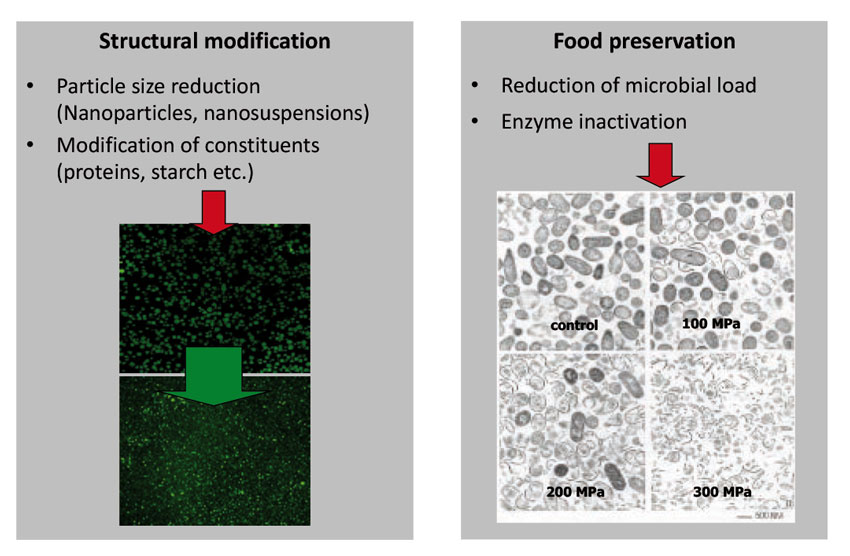Reduction Strategies for Fat, Sugar and Salt (Part 1)
DLG Expert report 8-2017
Author:
„ThinkTank Reduction2020“
- Dr. Mehmet Cicek, Fovation – Food & Innovation
- Dr. Malte Rubach, M.R. EXPERT
- Prof. Dr. Johannes Erdmann, Weihenstephan-Triesdorf University of Applied Science (Hochschule für angewandte Wissenschaften Weihenstephan-Triesdorf), Germany
- Prof. Dr. Helge Fritsch, Baden-Württemberg Cooperative State University (Duale Hochschule Baden-Württemberg) in Heilbronn, Germany
- Prof. Dr. Stefan Töpfl, University of Osnabrück (Hochschule Osnabrück), Germany
Contact:
- Simone Schiller, Managing Director of DLG Centre for Expertise on Foodstuffs (DLG-Fachzentrum Lebensmittel), S.Schiller@DLG.org
Introduction
Reduction2020 – less salt, sugar and fat. But how? This report is intended to give a constructive impression of the discussion on the right way to reduce the energy and salt content of foodstuffs by 2020, and above all to objectify it. In the opinion of the authors, the public debate conducted in the media is characterised by a one-sided naming of identical demands for increased regulation by the legislator and admonishing words regarding health development. Measures in nutrition education, a tax on sugar and new declaration requirements for nutritional information are being called for, and manufacturers are being asked to take responsibility for the consequences of consuming their products. But what is currently possible at all in 2017?
What technological options are available for a reduction strategy? And which constraints pose an obstacle to a possible reduction strategy and what changes in business and society are necessary to realise a reduction strategy? However, the evidence on just how useful reduction strategies really are is also being discussed. Based on the motto „It‘s only forbidden not to think at all“, an overview is provided of the current limits and options which were summarised as part of the event „Reduction2020 – less salt, sugar and fat. But how?“ that took place in March 2017 in Munich, Germany.
The first part of this report shows the current state of technology and especially looks at the use of dietary fibre and sugar substitutes. The second part shows, based on various perspectives, how ingredient suppliers and an established FMCG manufacturer address the subject of reduction and what role multi-sensory tests play in product development. The last part provides an evaluation of the possible impact of reformulation measures from an economic and nutritional medicine standpoint.
Advances in processing technology make reduction possible
Reduction is technologically feasible. Methods like high-pressure handling are suitable for improving the functionality of food ingredients. This can enable the formation of structures and binding of water, which are usually achieved by adding salt. However, the use of new technologies alone cannot guarantee that the taste preferences of the final customer already mentioned will be reliably met. Pressure-induced changes in the protein properties also enable, for example, the exchange of fat. This means for example the use of lean meat treated with high-pressure enables a salami with a fat content of 10 – 15% to be produced. However, consumer tests are then all the more decisive for finding the right taste.
Ultra-high pressure homogenisation is a promising treatment method for water and oil emulsions, such as mayonnaises and dressings. It results in a reduction in the fat droplet diameter, and therefore to an increase in stability with a considerably reduced fat content. On the other hand, the surface properties of potato products can be altered by using pulsed electrical fi elds so that a smoother cut is possible during processing. The smooth, intact surface structure decreases fat absorption during cooking or deep-frying by up to 30 %.In addition to this strategy for structural modifi cation, the sugar content of some foodstuffs can be reduced through the use of special microorganisms by means of fermentation. Another possibility for compensating structural properties of fat and sugar is the use of extrusion technologies suitable for forming new product structures. Vegetable proteins can be restructured with the specifi c use of shearing, pressure and heat so that an „al dente“, fi brous product results. This enables the production of alternatives to meat products with a low salt and fat content and without the addition of additives like emulsifi ers and thickeners.
Dietary fibres effectively reduce the energy density
Great potential is expected for the topic of dietary fi bres as a matrix-stabilising ingredient in the sense of energy reduction and reformulation of foodstuffs. The ingredients, also referred to as dietary fi bres, can be promoted as „fibre-enriched“ from a content of 3 g/100 g and from double that quantity as „high-fibre“. Technological processing of dietary fi bres has meanwhile been considerably simplifi ed through the use of concentrated dietary fi bres. Compared to the addition of bran, concentrated dietary fi bres are easier to dose and are suitable for effective enrichment due to a fi bre content of 98 percent without modifying the original food texture familiar to the consumer. In addition, the residue loads which occur in conjunction with natural bran, for example with mould toxins, can be avoided more easily with concentrates through cleaning, processing and a close-knit quality control system. Successful applications exist, for example, for energy-reduced baked goods and meat products, such as meat loaf.


Sugar substitutes already exist today
Sugar as an energy source is at the focus of criticism, especially as sweetened beverages and convenience snacks with a high sugar content quickly result in consumption of a caloric content equal to that of lunch or dinner if they are carelessly consumed. In recent years, not only sugar alcohols like sorbitol, known as saccharine, but also other sugar alternatives have been developed which are primarily characterized by a significantly reduced blood sugar reaction. The blood sugar level rises less steeply after food consumption, resulting in a lower insulin release, which also has a major influence on appetite regulation. With the disaccharide alcohol Isomalt, the producer Beneo has established a sugar substitute in this regard. It scores additional points with fewer calories and is therefore number one world-wide for use in sugar-free hard caramels and chewing gum products. An intermediate stage in the production of Isomalt from sucrose is Palatinose™. It also has the described effect on the blood sugar level. This effect was recognised by the European Food Safety Authority (EFSA) and can therefore be advertised with a health claim. Other developments in the field of sugar substitutes include fructans, which are manufactured with biotechnology and can also be produced from the soluble dietary fibre inulin.
Nutrition-based product changes – why and how?
With respect to the question „What is the right reduction strategy?“, in 2016 Nestlé presented how a reformulation strategy is conceived and advanced in a consumer goods company with over 6,000 products. According to this, reformulation cannot be assigned to the classic areas of prevention, like situational and behavioural prevention, as consumers ideally still enjoy their accustomed and desired products after reformulation and have not cause to make a conscious or unconscious change in their behaviour. As a result, the conclusion is correct that reformulation strategies of food manufacturers must be viewed more as their taking responsibility in the sense of public health than as a key approach for healthy nutrition.
With the development of the Nestlé Nutrition Profiling System (NNPS) at Nestlé, the content of critical ingredients like salt, sugar and fat, as well as individual minor ingredients (e.g. trans-fatty acids) was specifically reduced with reference to the recommendations for nutritional intake applicable world-wide. Here the focus was initially on products for which it was possible to reach a short-term reduction goal. In contrast, longer-term reduction projects are characterised by the fact that the retention of the accustomed sensory testing for the consumer requires several technological development cycles in order not to endanger the core attribute and with it the commercial success of the product. By means of the specified strategy, by 2020 Nestlé will succeed in reducing the sugar content of its entire product portfolio by 5 % – a quantity of 18,000 tonnes.
Driven by trends or what are good forecasts?
Prior to Reduction2020, the participants were surveyed on certain expectations for the development of the food industry. Today many changes in the market are market-driven and are not necessarily oriented on an actual need. The scene is spectacularly set for terms like „microbiome“, „dairy-free milk“ and „in-vitro meat“, so that one might get the impression that the next big thing is about to happen here. But no matter how much you love marketing, the fact is that despite all the attention it attracts, the market situation behaves differently than expected. One example of this are the meat substitute products. According to the „Gesellschaft für Konsumforschung“ (GfK - Association for Consumer Research), even at the time of the preliminary peak of the market introduction in 2015, they did not exceed a market share of 1.2% of the entire meat market, and in 2017 this figure was just 1.8%. Even the marketing efforts of the relevant manufacturers, who never tire of proclaiming the alleged or actual advantages of these alternatives, are of little help. Since the media-friendly portrayal of the first „in-vitro burger“ with a meatball from the laboratory of the Maastricht scientist Mark Post in 2015, the end of the traditional meat sector has repeatedly been predicted in this area as well, which the yellow press thankfully picks up and circulates. The psychologist Philip Tetlock from the University of California in Berkley exposed the problem with such vague clams in his recently published „Good Judgement Project“. The majority of all forecasts is disseminated by one and the same „experts“ and they are neither checked nor questioned with regard to their forecasts. These „experts“ not only appear in the public media. They also exist in every kind of organisation, regardless of whether it‘s companies, administrative bodies or NGOs. Two simple rules differentiate between good and bad forecasts: The specification of an anticipated likelihood of occurrence between 0 and 1 and a time horizon at which the expected event occurs. Based on this, it is possible with specific questions which specify the time horizon, to obtain the response of any desired persons on the probability of a certain event occurring or not. The example we‘ve named above would be: „Will in-vitro meat (meat substitute from cell cultures) be available in German supermarkets by 2020?“. On the average, this was answered by the participants of Reduction2020 with an anticipated likelihood of occurrence of 23 %, whereby 95 % of the answers fluctuated between 17% and 29%. The advantage of this survey is obvious: By observing the market situation, the same question could be asked with a shorter-term time horizon so that the anticipated likelihood of occurrence is adjusted to the actual changes. A problem which frequently occurs, is that forecasts are not always corrected when actually required by the circumstances. In addition, good and bad forecasters in the group of participants or in one‘s own organisation can be identified with the collective anticipated likelihood of occurrence of individual participants with a large number of questions and forecast cycles.
This example is intended to convey to the participants how, with a simple methodological procedure within one‘s own organisation, the topics important for the strategic company and product development can be quantifiably subjected to a forecast regime that after some time can produce not only good forecasts for decision-making processes, but also its own forecast team. Ideally, a forecast team can be supplemented with the classic market research which, although it does supply reliable data from the past, generally only offers a perceived reliability if trendresearch is practised on this basis.
The information graphic shows the future questions with the average anticipated likelihoods of occurrence after being answered by the participants. The error bars indicate that 95% of the answers are within this range.
The open communication of these kinds of reduction strategies is by no means commonplace. For example, a large number of stakeholders have been tracking a silent reformulation on the market for several years, as such announcements are not always also rewarded by consumers. There are plenty of examples in which a successful reduction project was actively communicated via marketing or at the point of sale and the customer nevertheless prefers a familiar product. General criticism was also expressed in this context to the effect that there is currently no „level playing field“ on which the industry could uniformly orient itself. On the part of the EU Commission, a binding Nutrition Profiling System was already announced, however this has not yet materialised.
Recognising and using multi-sensory effects
The potential of sensory testing and consumer research is also of varying importance for reduction projects. In the research and development sector of the food industry, the early use of sensory analysis and consumer tests has always been a basis for developing products in an efficient, goal-oriented manner which completely meet consumer demands. However, especially with reduction programs such as salt and fat reduction, it is imperative that the enjoyment value of a food be systematically decoded and the key sensory attributes responsible for the consumer‘s preference be holistically worked out with quantitative consumer tests and complementary descriptive sensory testing. This procedure enables the focus to be placed on sensory product properties which produce a direct consumer response when designing and technologically optimising a recipe. In the process, synergies between cross-modal sensory properties can be specifically used, which opens up new possibilities especially for reduction products with natural ingredients. For example, with salt reduction, the perceived salty taste can be positively influenced with both the simultaneous perception of additional basic tastes and the perception of culinary odours. In this so-called multi- sensory approach, product recipes can be optimised in order to completely satisfy both the claim to a balanced nutritional profile and the expected sensory enjoyment of the consumer.
Evaluation of reformulation strategies from the standpoint of health economics and nutritional medicine
The economics of calories – why not only the input side counts
A kind of economics exists for virtually every material and immaterial good. All economics follow a production theory in which a given input leads to the desired output, i.e. the product, through a transformation. From an economic standpoint, this production theory model is successful when an increased demand requires a higher output in the form of products so that the means of production employed can be quickly and efficiently utilised on the input side.
It is therefore also a sign of an inefficient production process when goods produced back up due to reduced output with an unchanging input, requiring stockpiling. In this case, stockpiling not only causes unnecessary costs. From an economic standpoint, the resources used for the production of the stored goods have also been used inefficiently.
The production theory model now supplies several easily derivable implications for an economy of calories. In the sense of a simple input-output analysis of the caloric intake, stockpiling results in case of an imbalance caused by an excessive intake and insufficient output of calories. This is recognisable as obesity or adiposity. This stockpiling has direct economic consequences for both the individual and for society. The available resources on the input side were not only used inefficiently, they also lead to an increase in the health economics follow-up costs of diet-related illnesses and to a direct reduction in the quality of life of the those concerned and indirectly to that of society. This is because of increased general health costs which limit investments in structures for increasing the quality of life of all people.
From an economic standpoint, intervention possibilities from several areas must be considered. Regulatory tax increases as a barrier to consumption on the input side are therefore a proven method with a major leverage effect, however only if they are applied at a sufficient level. This is politically not very opportunistic and therefore does not represent any real possibility for action. On the other hand, measures in nutritional therapy can be effective if they counteract an excessive caloric intake. However, here as well a restriction must be accepted: Nutritional therapy usually does not take effect until illness or risk findings exist. In this area this is referred to as secondary prevention. Conversely, in the area of primary prevention, this includes all people without illness or risk findings and there are hardly any effective instruments for positively influencing eating habits on the input side.
Measures in nutritional education are aimed at promoting the appreciation and the proper way of dealing with food, however the reality of daily life does not always allow most people to behave accordingly. Reduction strategies can therefore be a set screw for positively influencing the input side, however here as well, no effect is to be expected which causes a radical turnaround in eating behaviour. This is because for consumers, the taste and the enjoyment aspect of food are of primary importance. Both from the standpoint of the economic production theory of business and from the standpoint of the personal freedom of choice of consumers, this inner drive is very difficult to confront with reformulation strategies alone.
It is not enough to consider one isolated nutrient
A classification in nutritional medicine as to the „sense and nonsense of reduction strategies“ is frequently subjected to the allegation that reformulation as a measure should not be open to debate. The increase in the number of people affected by obesity and diabetes is already alarming in Germany and world-wide. To effectively counteract this trend, it is necessary to focus on what is essential. There is no question that the total caloric intake must be reduced. However, strategies which solely target a population-based macronutrient, such as the reduction of sugar or fat, fall short of the mark, regardless of whether a higher taxation of individual foodstuffs or their reformulation is concerned. Nutritionally, it is a matter of changing eating patterns so that a long-term energy reduction is brought about. At the same time however, it must be ensured that eating may still be enjoyable. Otherwise, the perseverance and acceptance of those concerned will very quickly be exhausted.
However, an adjusted product recipe does not automatically result in an improved product in the sense of consumer preference. Therefore, regardless of whether it is at least a matter of tasty new developments or of existing products, from the standpoint of nutritional medicine the energy density of foodstuffs provides the simplest orientation for everyday life. By the way, the energy density is indicated on every package and is therefore suitable for orientation in order to keep eating enjoyable, while at the same time being able to specifically control the energy intake as part of a balanced diet. Up until now, the effect of higher taxes on heavily sweetened products has not been documented with long-term health effects.
In addition, it must also be expected that in the price-embattled food trade, there are sufficient alternative products, such as store brands with a considerably lower price than the classic brand-name products. And this enables the price elasticity to easily compensate for the postulated benefits.
With regard to the salt content of food, reduction strategies are useful insofar as people who already suffer from hypertension are concerned. However, the decisive question here is whether salt sensitivity exists in order to achieve a health advantage. Having said this, for people with normal blood pressure and body weight, a salt reduction only plays a minor role. To be effective, concentrated efforts are required, both in the area of coping with everyday problems and in nutritional and consumer education. Guidance is one thing, but people still need to be able to (and allowed to) cook and choose themselves. This should be accompanied, especially against the background of the popularity of processed food products, by an attractive, tasty portfolio of food with a reduced energy density which can be drawn on when required.
Contact:
Simone Schiller, Managing Director of DLG Centre for Expertise on Foodstuffs (DLG-Fachzentrum Lebensmittel), S.Schiller@DLG.org









